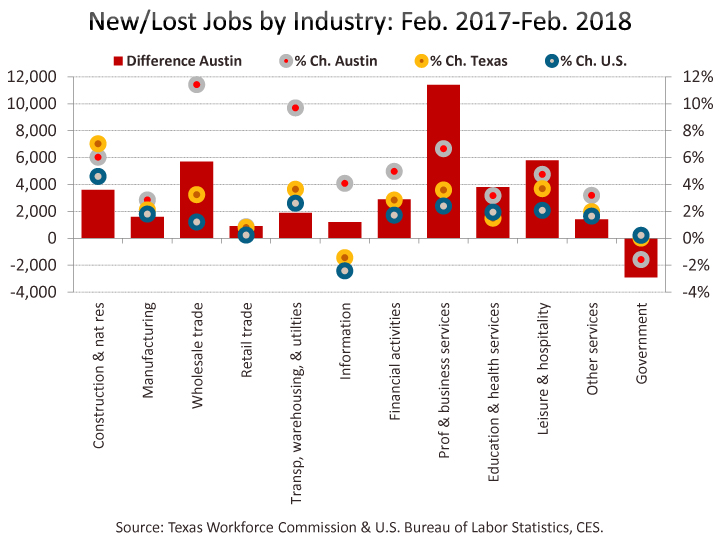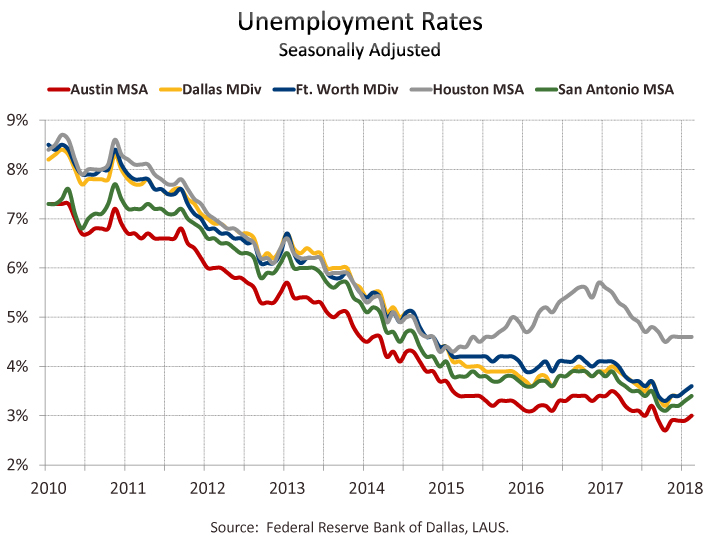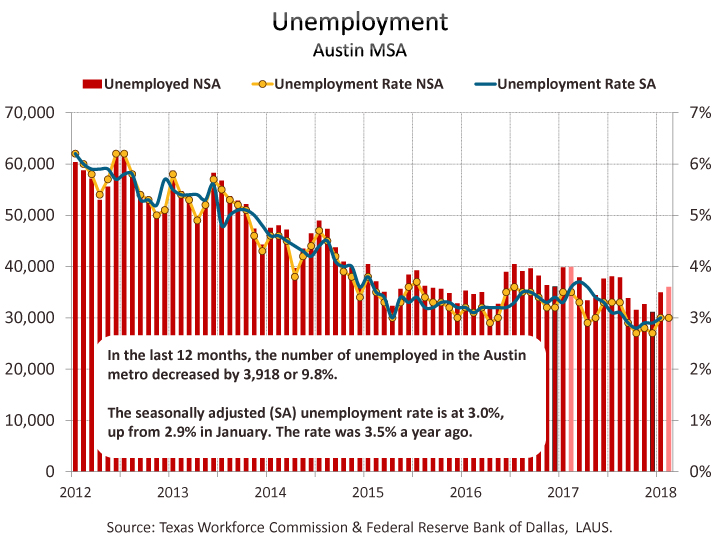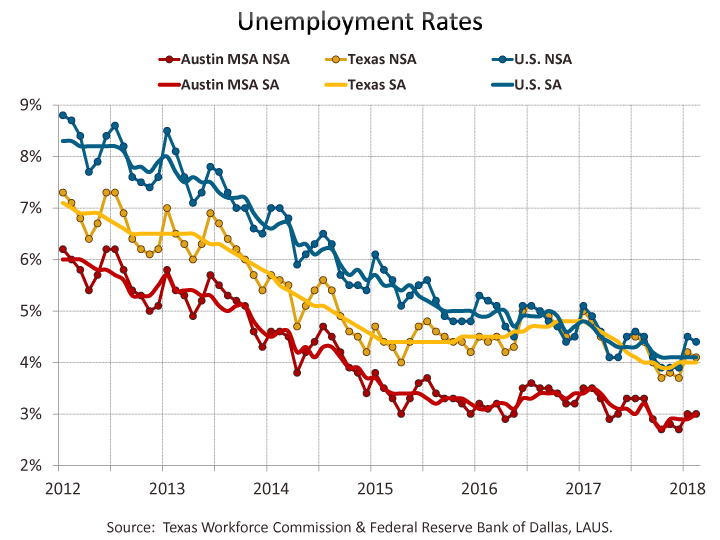Job Growth & Unemployment
Posted on 03/27/2018 by Beverly Kerr
- Austin added 37,300 net new jobs, growth of 3.7%, in the 12 months ending in February, making Austin the second fastest growing major metro.
- Wholesale trade was the fastest growing industry in the Austin MSA, increasing jobs by 11.4% (5,700 jobs) over the last 12 months. Professional and business services added the most jobs—11,400 (6.7% growth).
- Austin's seasonally adjusted unemployment rate is 3.0%, up from 2.9% in January.
The Austin metropolitan area added 37,300 net new jobs, or 3.7%, in the 12 months ending in February, according to Friday's releases of preliminary payroll jobs numbers by the Texas Workforce Commission (TWC) and the U.S. Bureau of Labor Statistics (BLS).

Austin’s 3.7% growth makes it the second best performing among the 50 largest metro areas. Dallas, up 2.8%, also mate the top 10, ranking seventh. Fort Worth (up 2.5%), San Antonio (up 2.4%), and Houston (up 2.2%) ranked 13th, 15th, and 18th respectively.

For the year ending in February, private sector job growth in the Austin MSA is 4.8%, or 40,200 jobs, with all private industry divisions adding jobs. Austin's sizable government sector (over 17% of jobs) saw jobs contract over the last 12 months, losing 2,900 jobs or 1.6%, thus bringing the overall job growth rate to 3.7%.

Texas saw net private sector job growth of 2.8% with all private industries, except one, adding jobs over the last 12 months. Total job growth was 2.4% as the government sector, which accounts for 16% of total state employment, was essentially unchanged. For the nation, private sector growth is 1.8% for the 12 months ending in February with all private industries, but one, adding jobs. Overall job growth is a more modest 1.6% because government sector growth was up a moderate 0.2%.

Jobs in February are up from the preceding month by 9,700 jobs or 0.9% in the not-seasonally-adjusted series for Austin. In the seasonally adjusted series, growth from January to February is 4,100 jobs or 0.4%. Seasonally adjusted jobs are up by 0.4% in Houston, 0.3% in Dallas and Fort Worth, and 0.2% in San Antonio. Statewide, seasonally adjusted jobs are up 40,500 or 0.3%. Nationally, seasonally adjusted jobs are up 0.2% from January.

In Austin, the industry adding the most jobs is professional and business, which grew by 11,400 jobs, or 6.7%, over the last 12 months. Wholesale trade grew fastest, at 11.4%, and added 5,700 jobs. Also growing at faster-than-average rates are transportation, warehousing and utilities (9.7% or 1,900 jobs); construction and natural resources (6.0% or 3,600 jobs); and financial activities (5.0% or 2,900 jobs). Click here for graphs of the 2012-2018 growth rate trends for major industry groups.

Statewide, construction and natural resources grew fastest, at 7.0%, and added the most jobs (64,100 jobs) over the last 12 months. The other relatively fast growing industries include professional and business services (3.6%); transportation, warehousing, and utilities (3.6%); and wholesale trade (3.2%). Jobs declined in information by 1.4%.
Nationally, construction and natural resources grew fastest, adding 4.6% over the 12 months ending in February. Transportation, warehousing, and utilities (2.6%); professional and business services (2.4%); and leisure and hospitality (2.1%) were also relatively fast growing. Information jobs fell by 2.4%.

The net gain for private service-providing industries in Austin is 35,000 jobs, or 4.9%, over the last 12 months. Employment in goods producing industries is up by 5,200 jobs or 4.5%. Statewide, private service-providing industries are up 206,300, or 2.5%, and goods producing industries are up 81,900 jobs, or 4.7%.
We also now have January labor force, employment, and unemployment numbers for Texas and local areas in Texas. The same data for all U.S. metros will not be released until April 4. In January, Austin had the fourth lowest rate of unemployment among the 50 largest metros.
Unemployment numbers for February show Austin’s performance relative to the state and other major Texas metros being sustained. In February, Austin is at 3.0%, while the other major metros range from 3.4% in San Antonio to 4.7% in Houston. Dallas and Fort Worth are at 3.7% and 3.6% respectively. Austin’s rate one year ago was 3.5%. The rates in Texas’ other major metros are also each below the rates seen a year ago. The statewide not-seasonally-adjusted rate is now 4.1%, down from 4.8% in February of last year. The national unemployment rate is 4.4%, improved from 4.9% in February 2017.

Within the Austin MSA, Travis County has the lowest unemployment rate in February, at 2.9%, while Caldwell County has the highest at 3.7%. The rate is 3.1% in Hays County, 3.2% in Williamson County, and 3.4% in Bastrop County.
On a seasonally adjusted basis, Austin’s February unemployment rate is 3.0%, up from 2.9% in January. The statewide rate is 4.0% unchanged from January. Nationally, the seasonally adjusted unemployment rate is 4.1% in February, also unchanged from January.
Among Texas’ major metros, San Antonio has the next lowest seasonally adjusted rate at 3.4%, Dallas and Fort Worth are at 3.6%, and Houston is at 4.6%. February rates are up from January in each metro except Houston, which is unchanged. Seasonally adjusted unemployment rates for Texas metros are produced by the Federal Reserve Bank of Dallas. (The TWC also produces seasonally adjusted rates for Texas metros, but publication lags the Dallas Fed’s data.)

With the decrease in Austin’s unemployment rate from one year ago, the number unemployed has also declined. In February 2017, Austin’s number of unemployed was 39,956. Over the last 12 months, the unemployed have decreased by 3,918, or 9.8%, to 36,038.

The Austin metro’s civilian labor force (employed plus unemployed) has increased by 4.0% or 45,251 persons from one year ago, while persons employed increased by 4.5% or 49,169. Texas has also seen greater growth in employed (3.1%) than labor force (2.4%), and the number unemployed decreased by 83,113 or 12.7%. Nationally, February civilian labor force is up by 1.3%, while employed is above the level of a year ago by 1.9%, and 796,000 fewer people (10.1%) are unemployed. Click here for graphs of the 2012-2018 growth rate trends for labor force and employment.

The Texas Workforce Commission will release March estimates on April 20.
The Chamber’s Economic Indicators page provides up-to-date historical spreadsheet versions of Austin, Texas and U.S. data for both the Current Employment Statistics (CES) and Local Area Unemployment Statistics (LAUS) data addressed above.
Related Categories: Central Texas Economy in Perspective